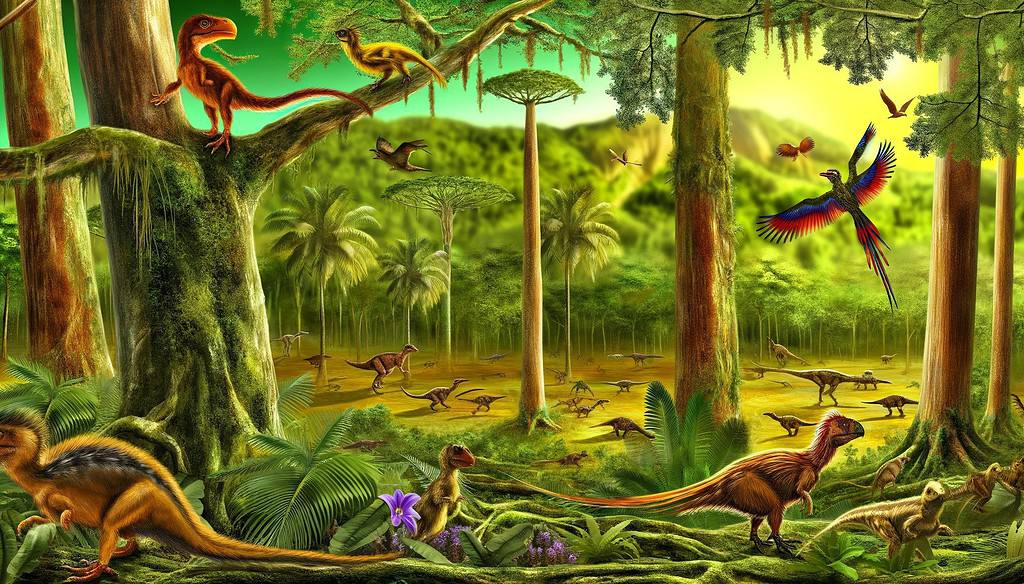
When we think of dinosaurs, colossal creatures, huge teeth, horns, and bony plates come to mind. Yet, that is not always the case. An equally fascinating and lesser-known aspect of dinosaur diversity is their size range, extending to some surprisingly small members. This article delves into ten of the smallest dinosaurs ever described, showcasing their unique adaptations and ecological niches.
From arboreal dinosaurs to insect and fish hunters, let’s meet these long-gone critters.
1. Oculudentavis: “Eye Tooth Bird”
| Family | Lepidosauria |
| Found in | Angbamo site, Myanmar |
| Diet | Carnivorous |
| Lived | ~98 mya |
| Length | 1.7 cm |
| Height | n/a |
| Weight estimate | 28 g |
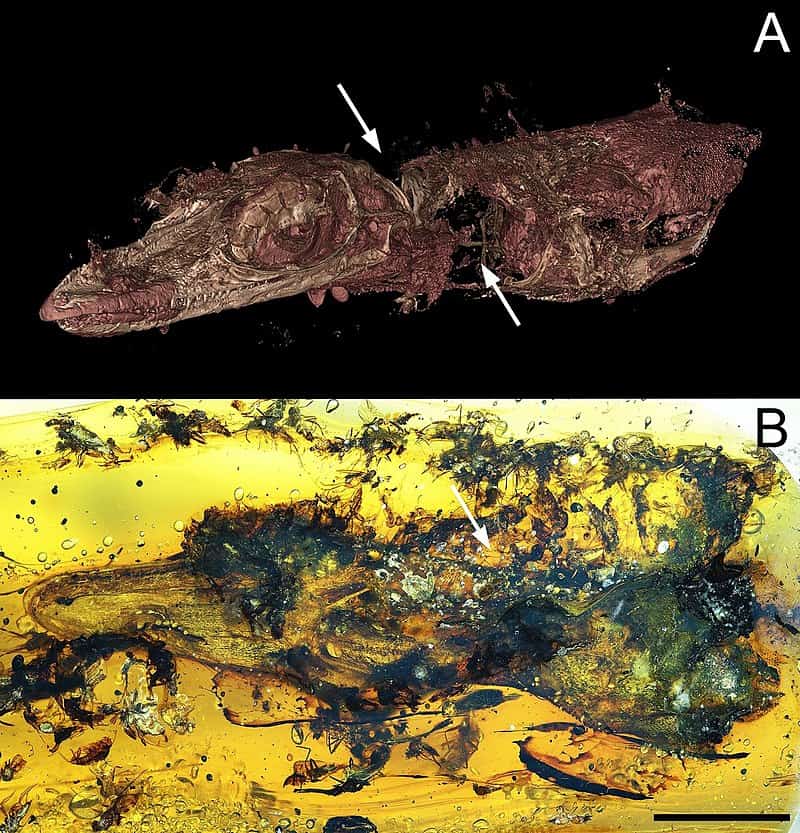
Oculudentavis is a subject of scientific intrigue, initially believed to be the smallest dinosaur. The confusion arose from Oculudentavis‘ bird-like features, such as a large eye cavity and a beak-like snout. However, closer examination revealed numerous lizard-like characteristics. The dinosaur had teeth fused to the jaw and specific skull bone shapes not found in birds. It also had a high tooth count and lacked an antorbital fenestra (an opening in the skull that is in front of the eye sockets), typical of avialan dinosaurs. However, scaly skin patches on its skull align more with lepidosaurs.
Oculudentavis lived in the lush, tropical forests of what is now Myanmar. This particular specimen became encapsulated in amber around 99 million years ago. It lived in a warm, humid climate alongside a variety of flora and fauna, with insects and small vertebrates which comprising its diet. Despite the controversy surrounding its classification as a dinosaur, Oculudentavis is a notable mention for this list.
2. Anchiornis: “Near Bird”
| Family | Anchiornithidae |
| Found in | Tiaojishan Formation, China |
| Diet | Carnivorous |
| Lived | ~160 mya |
| Length | 60 cm |
| Height | 34 cm |
| Weight estimate | 1 kg |
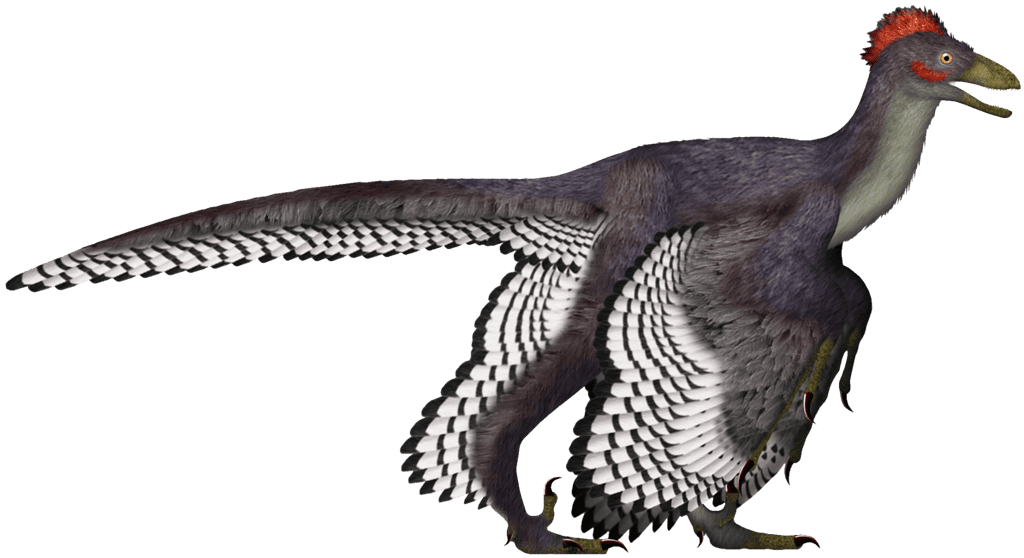
Anchiornis made its first appearance during the Late Jurassic period. Discovered in the Tiaojishan Formation of Liaoning, China, this small, bird-like dinosaur is often dubbed one of the missing links between reptiles and birds. This bipedal theropod boasted a triangular skull, akin to dromaeosaurids and troodontids. Anchiornis featured long, vaned feathers on the wings, legs, and tail with simpler feathers covering the rest of its body. Anchiornis also sported long feathers possibly forming a crest on its head, suggesting it had a “shaggier” plumage compared to modern birds.
Anchiornis lived in lush forest areas around deep lakes and mountain streams. Its diet likely consisted of small lizards and fish, as shown by fossilized gastric pellets. While initially thought to be capable of flight, further research suggests that while juveniles might achieve powered flight, adults likely used their wings to assist in running, leaping, and possibly even gliding. Anchiornis‘ plumage had contrasting white and black feathers which might have aided in predator evasion, akin to the dazzle camouflage seen in zebras.
3. Microraptor: “Micro Thief”
| Family | Dromaeosauridae |
| Found in | Liaoning, China |
| Diet | Carnivorous |
| Lived | 125-120 mya |
| Length | 1.2 m |
| Height | 77 cm |
| Weight estimate | 1 kg |

Microraptor, a crow-sized theropod with a four-winged design, lived during the Early Cretaceous period, approximately 125 million years ago. Discovered in China, Microraptor’s most striking feature was its feathers on all four limbs, suggesting the ability to glide. This dinosaur weighed around one kilogram and had a wingspan of about 70 centimeters. Its iridescent black plumage was similar to modern birds and could have been used for display and sexual behavior.
Microraptor’s abundance in fossil records, with over 300 specimens identified, indicates it must have been very common in its ecosystem. Scientists believe that Microraptor was arboreal, spending much of its time in trees, an adaptation supported by its anatomy which was not well-suited for ground movement.
Despite its small size, Microraptor was a carnivore, preying on small animals and insects. Its diet likely included small vertebrates like reptiles, mammals, fish, and primitive birds. The discovery of mammal bones in a Microraptor’s abdomen highlights its predatory nature. Its large eyes and sharp, pointed teeth suggest it was a hunter, capable of ambush tactics. Microraptor might have used its agility and potentially its flight capabilities to capture prey, navigating the forest canopy with ease.
4. Parvicursor: “Small Runner”
| Family | Alvarezsauridae |
| Found in | Barun Goyot Formation, Mongolia |
| Diet | Carnivorous |
| Lived | ~72 mya |
| Length | 39 cm |
| Height | ~25 cm |
| Weight estimate | 162 g |
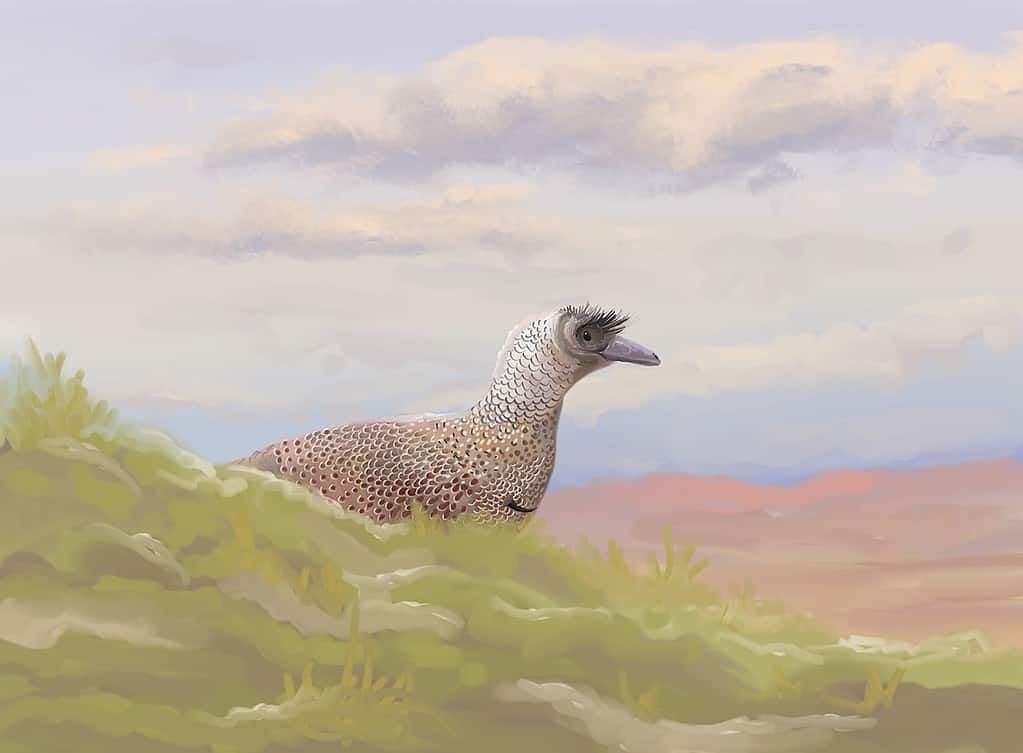
Parvicursor was a genus of diminutive maniraptoran with odd one-claw hands and long slender legs adapted for fast running. It was one of the smallest non-avian dinosaurs, measuring only about 39 centimeters in length and as heavy as 162 grams. Its fossils, discovered in the Barun Goyot formation of Mongolia, indicate a creature adapted to quick, agile movements, either for evading predators or catching prey.
This tiny carnivore lived during the Late Cretaceous period, around 72 million years ago. Parvicursor apparently had a highly specialized lifestyle, despite being as large as a parrot. Its leg and hip anatomy suggests an ability to sprint with high-speed maneuverability necessary for survival in its environment. The specific adaptations of its one-claw hands suggest a complex behavior pattern. These hands might have possibly helped with social interactions, although much of this remains speculative due to limited fossil evidence. While only one specimen of Parvicursor has been found, its morphology suggests a diet primarily consisting of insects.
5. Epidexipteryx: “Display Feather”
| Family | Scansoriopterygidae |
| Found in | Daohugou, Mongolia |
| Diet | Carnivorous |
| Lived | 168-152 mya |
| Length | 45 cm |
| Height | ~25 cm |
| Weight estimate | 164 g |
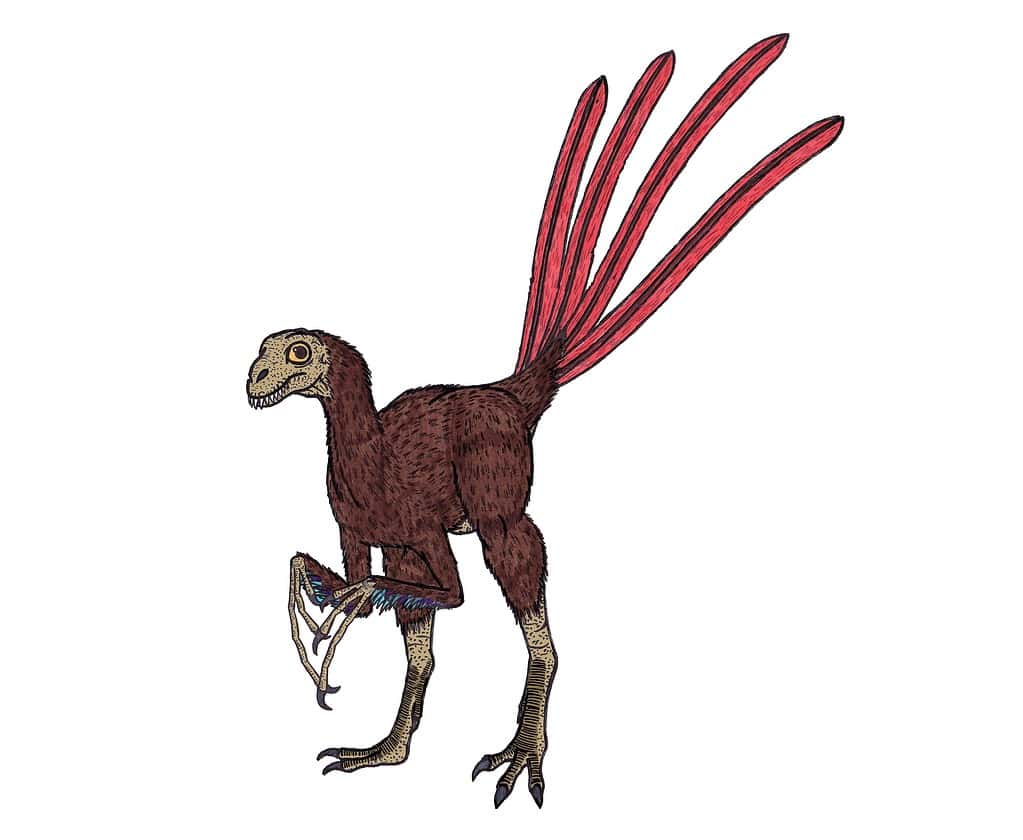
Epidexipteryx is a small theropod found to have unique ornamental feathers, particularly four long feathers on its tail. These feathers were not for flight but likely for display and insulation, indicating a behavior possibly related to social status. It only measured about 45 centimeters including the tail feathers, and weighed around 164 grams. Its skull featured a short snout with sharp teeth adapted for predation. The small dinosaur’s hands possessed long digits, characteristic of paravian dinosaurs, aiding in climbing. The diet of Epidexipteryx consisted mainly of small insects, worms, and larvae, matching its small stature.
Epidexipteryx lived during the Middle to Late Jurassic Period, 168 to 152 million years ago, in present-day Mongolia. This dinosaur lived in forest areas, using its climbing abilities and potentially gliding from tree to tree. Despite lacking the capability for powered flight, the structure of its limbs suggests it was adapted to an arboreal life.
6. Mei Long: “Soundly Sleeping Dragon”
| Family | Troodontidae |
| Found in | Yixian Formation, China |
| Diet | Carnivorous |
| Lived | ~125 mya |
| Length | ~53 cm (juvenile) |
| Height | n/a |
| Weight estimate | n/a |
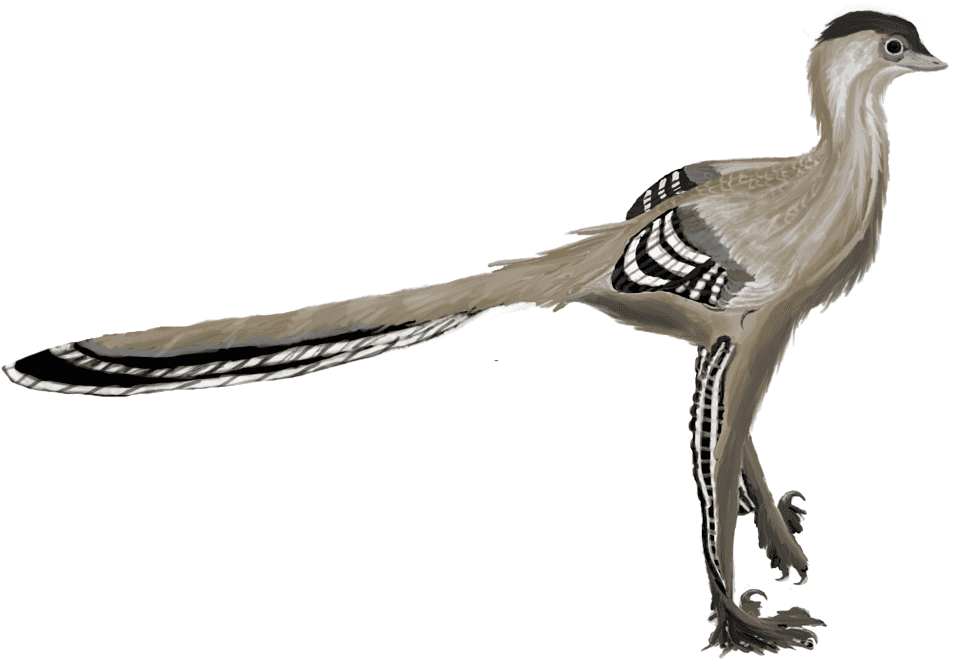
Mei Long, translating to “Soundly Sleeping Dragon” in Chinese, was a duck-sized troodontid dinosaur from the Yixian Formation of Liaoning, China, dating back to the Early Cretaceous period, about 125 million years ago. The dinosaur’s fossil posture in which it was found, in a bird-like sleeping posture, with its head tucked under a forelimb, has baffled paleontologists. This posture, similar to the roosting position of modern birds, suggests behavioral connections between extinct dinosaurs and birds.
The fossil’s 3D preservation was likely due to rapid burial in volcanic ash, possibly after being overcome by poisonous gases from a volcanic eruption. The discovery of Mei Long suggests that some non-avian dinosaurs, like their avian descendants, also exhibited warm-blooded characteristics.
Mei Long had several unique features, including large nares and a set of closely spaced teeth in the lower jaw. These features, along with its bird-like hip structure, place Mei Long near the base of the troodontid family. Thus, the “dragon” was likely behaviorally advanced and intelligent, with keen senses. Mei Long’s diet likely included small lizards and insects, and its long legs suggest it was a fast runner, possibly using trees for shelter from larger predators.
7. Bambiraptor: “Juvenile Thief”
| Family | Dromaeosauridae |
| Found in | Glacier National Park, Montana |
| Diet | Carnivorous |
| Lived | 72-70 mya |
| Length | 90 cm |
| Height | ~30 cm |
| Weight estimate | 2 kg |
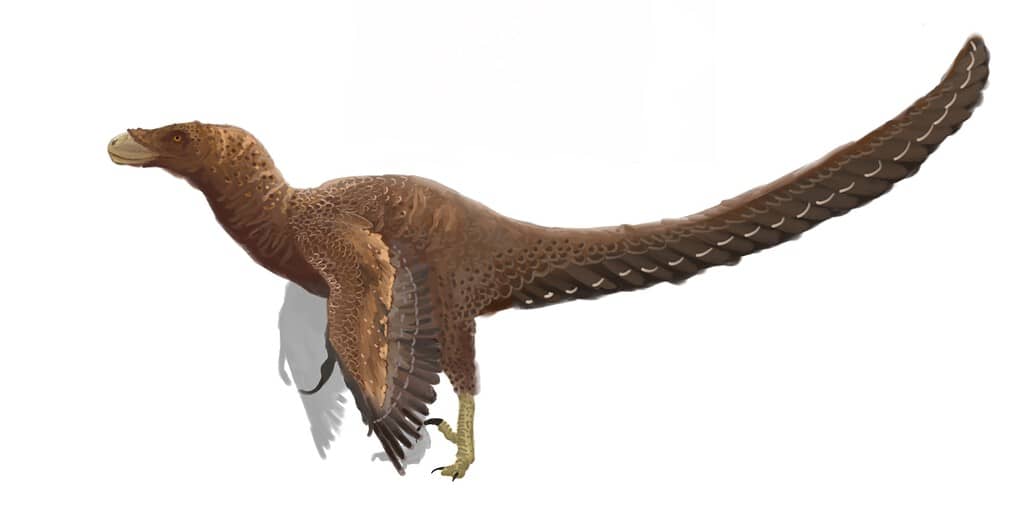
Bambiraptor, a small, bird-like dinosaur, lived around 72-70 million years ago during the late Cretaceous Period. Wes Linster discovered this dinosaur when he was only 14 years old in 1993 in Glacier National Park, Montana. Bambiraptor’s has one of the most complete skeletons ever found, a staggering 95% complete fossil. The “Bambi” in its name actually refers to the young age of the first specimen that was found. Therefore, a more accurate translation of the name would be “Juvenile Thief”.
Bambiraptor, primarily known from a juvenile specimen, had a length of about 90 centimeters. It had an estimated total length of one meter, and likely weighed around two kilograms. Bambiraptor was a swift runner with bird-like features, such as its very long arms with a well-developed wishbone. The holotype specimen’s brain size was within the lower range of modern birds, suggesting higher intelligence and agility akin to dromaeosaurids. Research indicates that Bambiraptor might have had the ability to “hold” food with its front limbs and bring it to its mouth. Its diet likely consisted of insects, dinosaur eggs, small reptiles, or mammals, fitting its carnivorous nature.
8. Micropachycephalosaurus: “Micro Thick-Headed Lizard”
| Family | Ceratopsia |
| Found in | Jiangjunding Formation, China |
| Diet | Herbivorous |
| Lived | ~70 mya |
| Length | 1 m |
| Height | ~30 cm |
| Weight estimate | 10-15 kg |

Micropachycephalosaurus, translating to “micro thick-headed lizard,” was a genus of small, herbivorous dinosaurs that lived during the Late Cretaceous period, about 70 million years ago. It is notable for being one of the smallest dinosaurs ever discovered and for having the longest name of any dinosaur. Despite its name suggesting a relation to Pachycephalosaurs, Micropachycephalosaurus is classified within the Ceratopsian group.
Scientists estimate this dinosaur was to have grown about two meters long and weighed around 10 to 15 kilograms. It featured a thick skull, flattened side to side, with large eye sockets and a short snout. Micropachycephalosaurus was a herbivore, using its column-like teeth with vertical ridges to grind tough plant material. Evidence suggests that it had social behavior, living in herds or groups. It may have used its thick skull in head-butting contests, possibly for mating rituals or establishing dominance within its group.
9. Compsognathus: “Pretty Jaw”
| Family | Compsognathidae |
| Found in | Bavaria, Germany |
| Diet | Carnivorous |
| Lived | 150 mya |
| Length | 1 m |
| Height | 0.3 m |
| Weight estimate | 3 kg |

Compsognathus, the “Pretty jaw,” is a small theropod dinosaur that lived approximately 150 million years ago during the Late Jurassic. Paleontologists first described this dinosaur from two nearly complete skeletons, found in Germany and France. It was the first theropod dinosaur known from a reasonably complete fossil skeleton.
The one-meter-long Compsognathus was once considered the smallest-known non-avian dinosaur. It was a carnivore, feeding mainly on small animals. Its diet is known with certainty thanks to the preserved remains of small lizards found within the bellies of both known specimens. Compsognathus had long, narrow legs, a long tail for balance, and sharp teeth and claws designed for grasping small animals. The German specimen, possibly a juvenile, is smaller than the French specimen, which offers insight into the dinosaur’s growth and size variation.
10. Liaoningosaurus: “Liaoning Lizard”
| Family | Ankylosauridae |
| Found in | Liaoning, China |
| Diet | Carnivorous |
| Lived | 125-119 mya |
| Length | 34-40 cm |
| Height | n/a |
| Weight estimate | n/a |

Liaoningosaurus, a fascinating genus from the Ankylosauria suborder, hails from the Early Cretaceous period in China’s Liaoning Province. This dinosaur, known specifically as Liaoningosaurus paradoxus, is a paradox for scientists as it is the first carnivorous ornithischian discovered.
Initially described in 2001, Liaoningosaurus fossils were unearthed from the Yixian Formation. The type specimen measured only about 34 to 40 centimeters in length. Liaoningosaurus displayed unique features alongside slender teeth with few denticles, suggesting a fish-eating diet. This semi-aquatic lifestyle hypothesis stems from the dinosaur’s skeletal features and the preserved fish skeletons within the gut contents of the holotype, a deviation from the typical herbivorous ankylosaurid. Its classification has been debated, but recent analyses suggest Liaoningosaurus as a basal ankylosaurid, although its exact place within this family tree remains under discussion.



